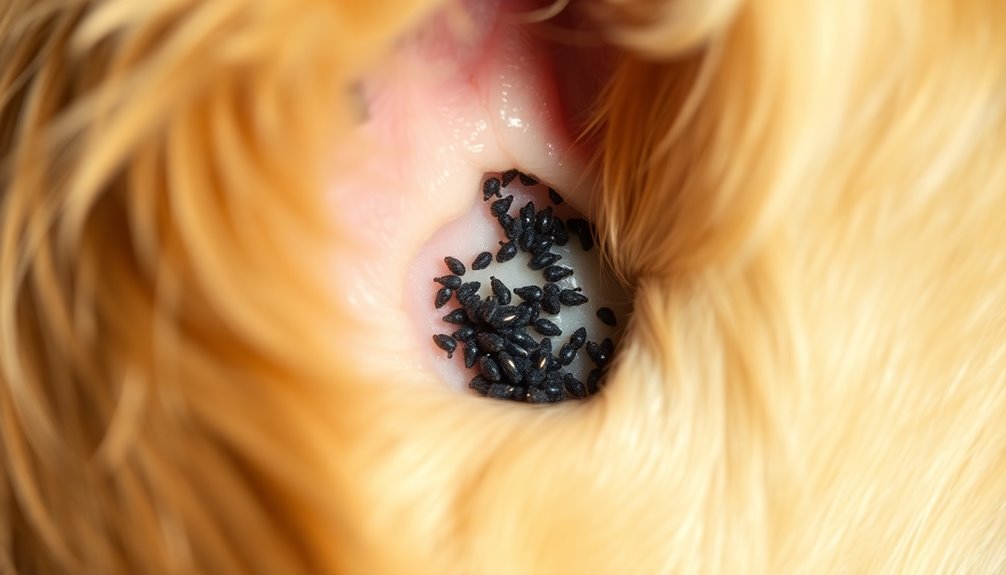When it comes to dog ear mites and ear wax, knowing the difference can spare your pup discomfort. Ear mites are tiny parasites that cause intense itching, dark crumbly discharge, and even inflammation. In contrast, ear wax is a natural substance that can accumulate and lead to irritation if not cleaned regularly. While ear wax has a mild odor, mite debris often smells foul. Regular vet visits are important for proper diagnosis and treatment. Understanding these symptoms and treatments can keep your furry friend healthy, so stick around to learn more about effectively managing their ear health!
Key Takeaways
- Dog ear mites are parasites causing itching and dark crumbly discharge, while ear wax is a natural buildup that can lead to discomfort.
- Ear mites often result in inflammation, redness, and hair loss around the ears, unlike the typically odorless ear wax.
- Visual inspection can differentiate them: ear wax appears brown and strong-smelling, while ear mite debris resembles dark coffee grounds.
- Treatment for ear mites requires veterinary intervention, including medication, whereas ear wax can often be managed with regular cleaning.
- Regular check-ups and ear inspections can help prevent complications from both ear mites and excessive ear wax accumulation.
Understanding Dog Ear Mites
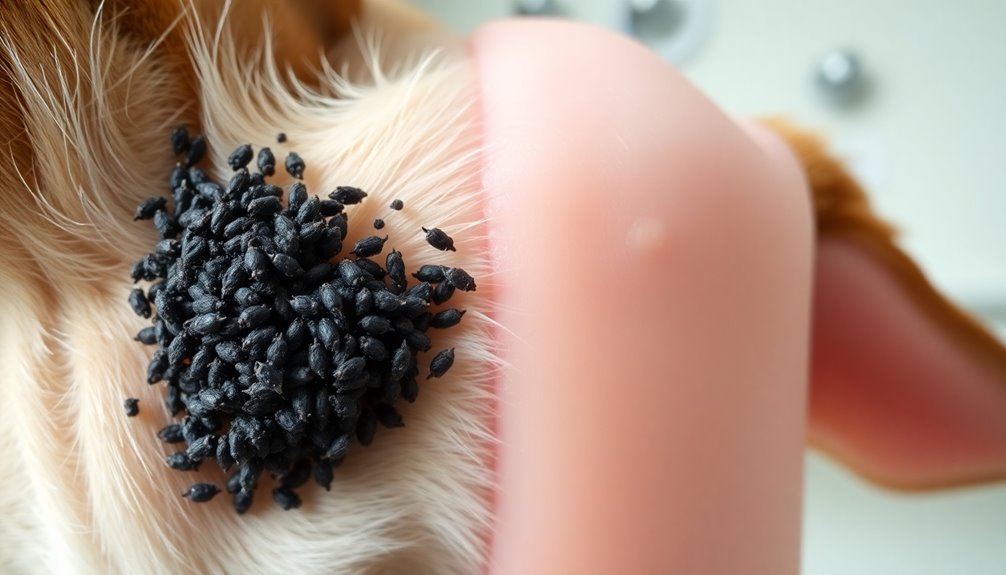
When it comes to your dog's ear health, understanding dog ear mites is crucial. These tiny pests, scientifically known as Otodectes cynotis, live in your dog's ear canal and can cause significant discomfort. You might not even see them because they're barely visible, looking like small white dots.
If your dog is scratching at their ears or shaking their head frequently, it could be a sign of ear mites. You may notice dark brown or black dry discharge that resembles coffee grounds, which indicates a potential infestation. The constant scratching can lead to skin lesions, inflammation, and even secondary infections from cuts. Heavy infestations can also lead to mites invading other body parts, worsening your dog's condition.
Complications can escalate quickly, resulting in issues like aural hematomas, where blood blisters form due to excessive scratching. If you notice unpleasant odors or changes in your dog's appetite, the situation may have become severe.
To diagnose ear mites, a vet will examine your dog's ear canal with an otoscope and check for discharge under a microscope. Treatment typically includes thorough ear cleaning and approved medications, so be sure to follow through with the entire treatment course for the best results.
What Is Dog Ear Wax?
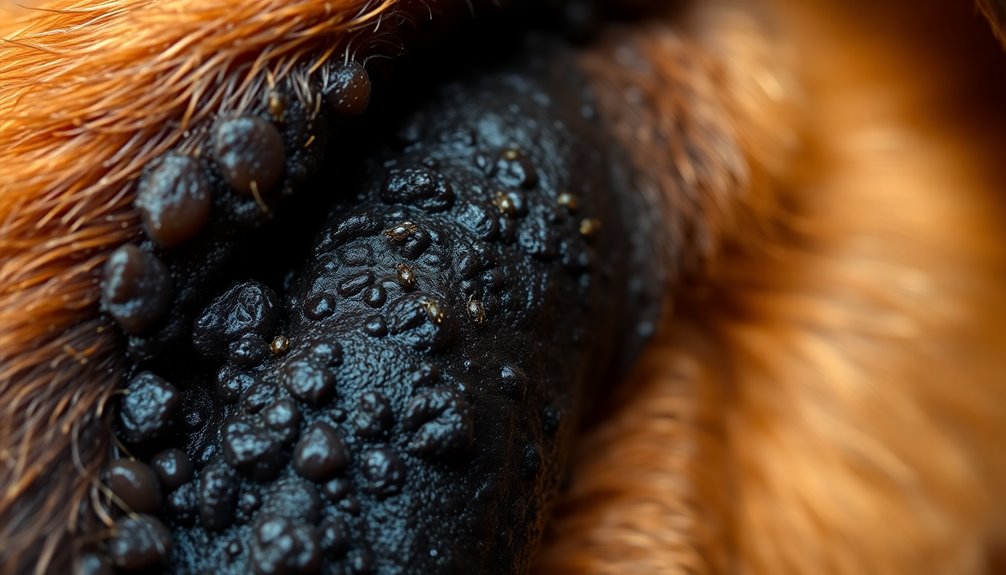
Dog ear wax, also known as cerumen, is a natural substance produced by glands in your dog's ear canal. This light brown to yellowish wax has a soft, slightly sticky texture and serves an important purpose. It protects your dog's ears by trapping dust, debris, and microorganisms, helping to maintain ear health.
Dog ear wax consists of fatty acids like oleic, myristic, and carnaubic, as well as waxes such as olein, palmitin, and stearin. Acetic acid helps make these waxes more soluble, ensuring they can be cleaned away when necessary. Typically, ear wax is odorless or has a mild, non-offensive smell. However, excessive ear wax accumulation can lead to discomfort and potential infections. If you notice brownish wax or a strong odor, it might be time to take action. Regularly checking and cleaning your dog's ears can prevent buildup, and using pet ear wipes or over-the-counter ear drops can help manage the situation. Don't hesitate to reach out to your veterinarian if you see any signs of infection or impacted wax; their guidance will be crucial for your pup's ear health. Normal ear wax is typically yellow to brown, soft, and odorless, making it essential to differentiate between healthy and problematic ear wax.
Symptoms of Ear Mites
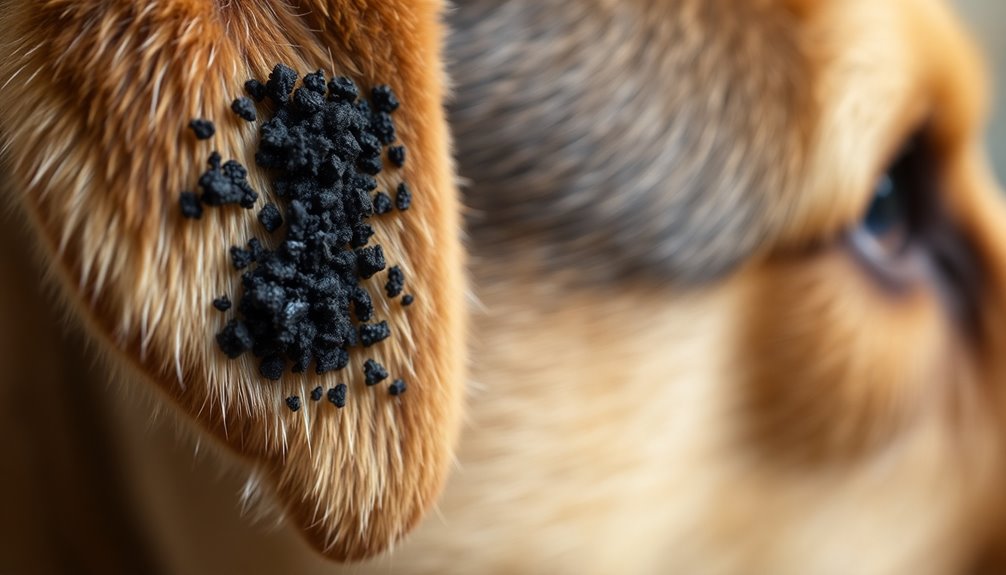
Many pet owners might notice their dog exhibiting unusual behaviors or physical signs that indicate a possible ear mite infestation. One of the most common symptoms is itching. You may see your dog frequently scratching around the ears, which can lead to scabs or abrasions at the base of the ear. Pay attention to head-shaking too; continuous side-to-side movement can signal discomfort.
Look for dark, crumbly discharge that resembles coffee grounds in your dog's ears. This reddish-brown discharge often comes with a foul odor, indicating an inflammation that could be painful. If you notice redness and swelling around the ears, it's a strong sign of ear mites. Dog ear mites are external parasites that can cause infections if left untreated. Additionally, ear mites can lead to gastrointestinal upset in some cases due to the stress and irritation they cause.
Behavioral changes can also be telling. Your dog might express pain when you touch its ears or resist handling altogether. Increased restlessness and scratching around the head and neck may indicate ear discomfort.
Lastly, keep an eye out for hair loss in the area surrounding the ears, as well as potential secondary complications like infections from scratching. Recognizing these symptoms early can help you seek veterinary care and relief for your furry friend.
Symptoms of Ear Wax
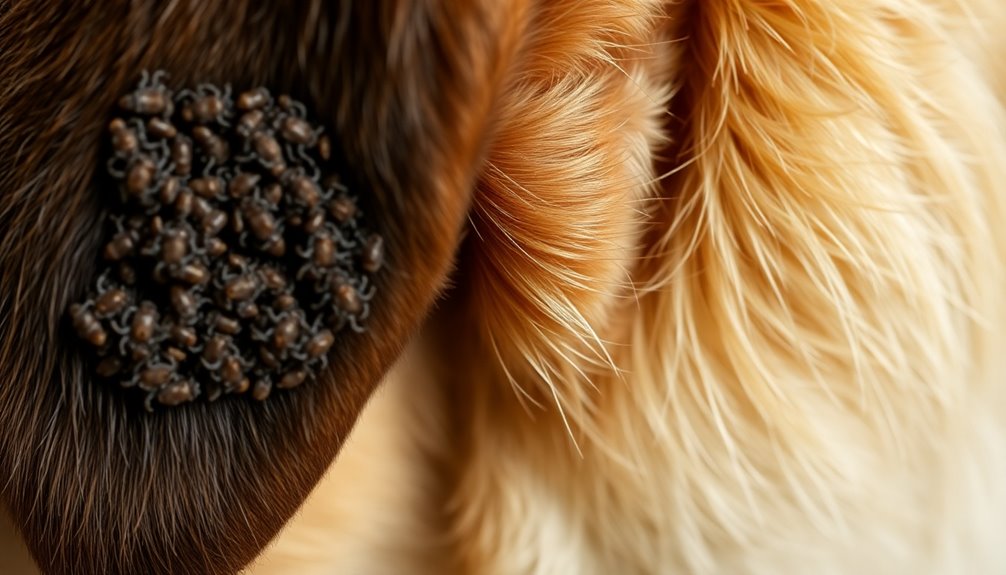
In the case of ear wax buildup, you might notice several physical indicators that signal a potential issue. Look out for brown or dark-colored discharge and visible wax accumulation in the ear canal. The skin around the ears may appear crusty, scabby, red, or irritated, and you might notice your dog's ears feeling hot and emitting a strong, unpleasant odor. Additionally, excessive earwax may indicate potential issues that require veterinary attention.
Behaviorally, your dog may start shaking its head excessively or trying to scratch or rub its ears more than usual. Tilting its head from side to side and constant ear movement can also indicate discomfort.
Sensory symptoms could include pain or discomfort in the ears, and you might see redness and inflammation in the ear canal. While less common, your dog may even express a sense of fullness in the ear or show signs of hearing loss or increased sensitivity.
If you observe these symptoms, it's important to schedule a veterinary examination. Your vet may use an otoscope or microscope to inspect the ear canal and recommend specific cleansing agents or medications to resolve the issue. Regular ear cleaning can help prevent these problems.
How to Differentiate Them

When trying to differentiate between ear mites and ear wax in your dog's ears, a careful examination is key. Start with a visual inspection. Ear wax typically appears brownish and may have a strong odor, while ear mite debris resembles dark, crumbly coffee grounds. If you see a dark discharge, that's a strong indication of ear mites.
Next, examine the ear canal for signs of inflammation, redness, or blisters. These symptoms are more common with ear mites, which cause irritation and discomfort. If you notice hair loss around the ears, it could further suggest an ear mite infestation. Ear issues are prevalent in the canine population and often require veterinary attention for accurate diagnosis.
For a definitive diagnosis, a vet's microscopic examination is essential. They'll use specialized tools to look for the presence of mites and their waste. Remember, ear wax is a natural substance produced by your dog's ear glands, whereas ear mites are parasites that can spread easily among dogs.
Treatment Options Available
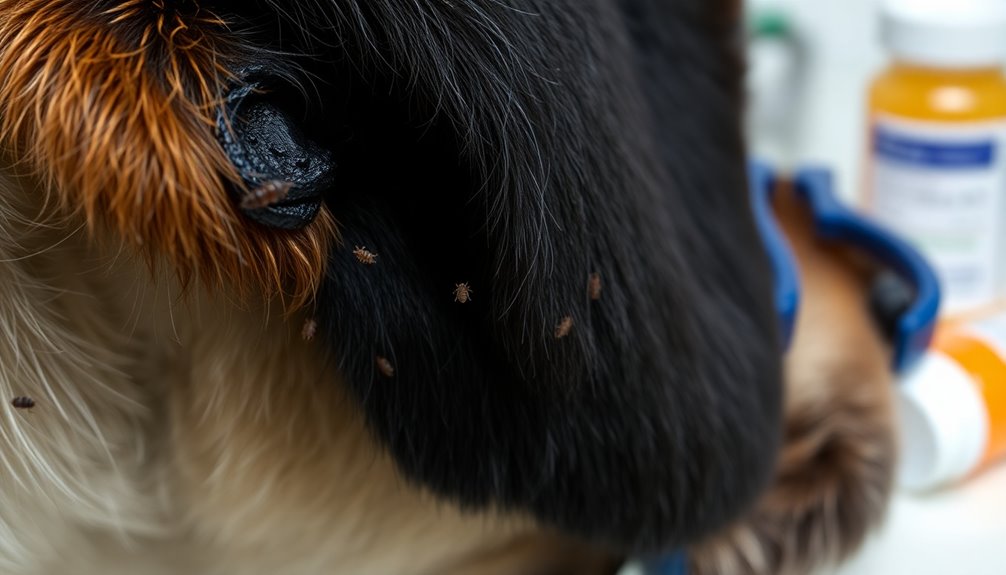
Effective treatment options are crucial for managing both ear mites and ear wax in your dog. For ear mites, start with a veterinary diagnosis and thorough cleaning. Your vet may use an otoscope to confirm the presence of mites and recommend ear cleansers like Epi-Otic® Advanced. Prescription medications, such as topical treatments like Revolution or oral medications in flea and tick preventatives, can effectively target the mites. If your dog has secondary infections, they might need additional medications like TrizULTRA™+ Keto Flush. It's important to note that ear mites are highly contagious, so prompt treatment is essential to prevent spreading to other pets.
For ear wax buildup, regular cleaning with veterinarian-recommended ear cleaners is essential. You can also use pet ear wipes containing soothing agents to maintain hygiene. Address any underlying issues, such as allergies, that may contribute to excessive wax production. Gentle home care is vital, so avoid pushing wax further into the ear canal during cleaning.
Always consult your veterinarian for tailored advice and follow their instructions diligently. Regular check-ups will ensure your dog's ear health remains optimal, and if one pet is treated for ear mites, it's wise to treat all pets in the household to prevent recurrence.
Prevention Tips for Healthy Ears
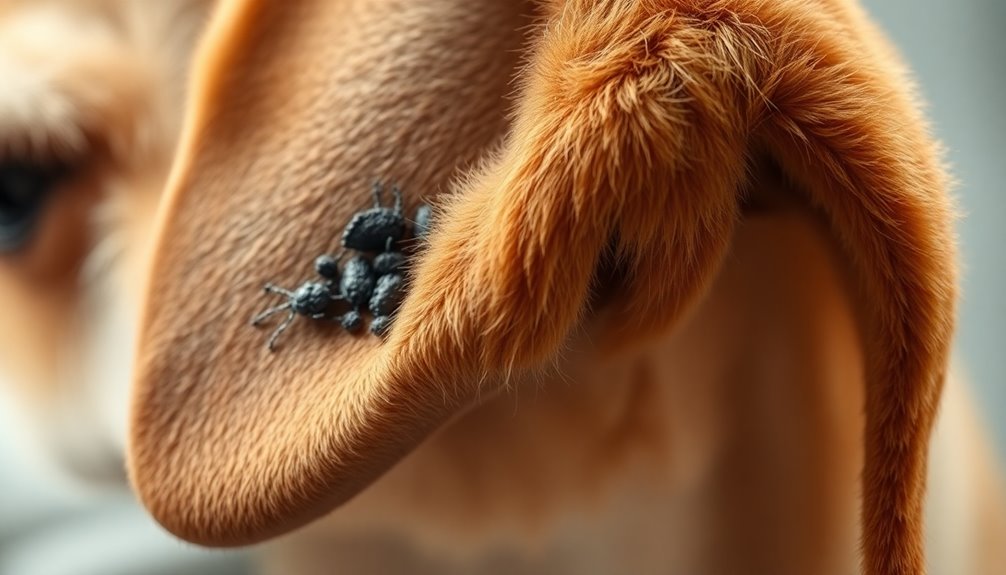
Keeping your dog's ears healthy starts with routine care and preventive measures. Start by cleaning your dog's ears at least once a month using a gentle, vet-recommended ear wash. Avoid cotton swabs; instead, use a cotton ball dipped in the cleaner to gently wipe away wax and debris. Regular cleanings help maintain ear health and hygiene, supporting overall dog wellness and activity levels. Additionally, using a vet-recommended cleaner can help to eliminate any ear mites that may be present. Regular cleaning can also improve air quality in your home, especially if you use an air purifier to reduce allergens.
It's important to remember that regular ear care can also prevent ear infections that are common in many breeds.
After swimming or bathing, dry your dog's ears thoroughly to prevent moisture buildup. Pat them down with a towel and use a cotton ball to absorb excess water. Consider ear-drying solutions if needed to help eliminate trapped moisture.
Minimize debris and irritants by checking your dog's ears regularly for ticks, dirt, or any injuries. Limit your dog's contact with other animals that may have ear mites, and keep them away from allergens that could trigger infections. Trimming the hair around the ears can improve air circulation and reduce infection risks.
Don't forget to schedule regular vet check-ups to monitor ear health and address any issues early. Ensure your dog has a balanced diet to support overall health. Watch for signs of infection like redness or excessive itching, and act quickly if you notice any symptoms.
Frequently Asked Questions
Can Dog Ear Mites Affect Other Pets in the Household?
Yes, dog ear mites can definitely affect other pets in your household. These highly contagious arachnids spread easily through direct contact, whether it's from playing together or sharing toys and bedding. If one pet gets infected, it's likely that others will too. You'll want to keep an eye on all your animals for symptoms like intense itching or dark discharge. Treating everyone at once is essential to prevent re-infestation.
How Often Should I Clean My Dog's Ears?
You should clean your dog's ears every 1 to 2 months if they're healthy. However, certain breeds, especially those with floppy ears or excessive hair, may need more frequent cleaning. Keep an eye out for signs like scratching or unusual discharge, which indicate a need for more attention. Regular inspections help catch issues early, so don't skip this important part of your dog's grooming routine. Always consult your vet if you're uncertain.
Are Certain Dog Breeds More Prone to Ear Issues?
Yes, certain dog breeds are more prone to ear issues. Basset Hounds, Chinese Shar Peis, and Labradoodles are particularly susceptible. Breeds with long, floppy ears, like Beagles and Golden Retrievers, also face higher risks due to trapped dirt and bacteria. Regular ear cleaning is essential for these breeds to prevent infections. If your dog belongs to a high-risk breed, keeping an eye on their ear health is crucial to avoid complications.
What Are the Long-Term Effects of Untreated Ear Mites?
If you leave ear mites untreated, your dog could face serious long-term effects. You might notice permanent damage to the inner ear, leading to potential hearing loss and increased risk of infections. Chronic discomfort can cause your dog to scratch excessively, resulting in cuts and secondary infections. Their quality of life could decline due to constant pain and irritation, so it's crucial to address ear mites promptly to prevent these lasting issues.
Can Diet Influence My Dog's Ear Health?
Yes, your dog's diet can significantly influence their ear health. Feeding them a raw, meat-based diet lowers the risk of ear infections, while highly processed dry foods can increase that risk. During critical growth periods, especially from 2 to 6 months, what you feed them shapes their immune system. Consistent, high-quality diets, free from artificial additives, help maintain their ear health and reduce the likelihood of chronic issues.
Conclusion
In conclusion, knowing the difference between dog ear mites and ear wax is crucial for your pup's health. If you notice any symptoms, don't hesitate to consult your vet for an accurate diagnosis and treatment. Regular ear checks can help you catch issues early, keeping your furry friend comfortable and happy. By following prevention tips, you can maintain healthy ears and ensure your dog stays free from discomfort. Trust your instincts and take action when needed!
